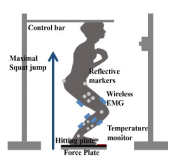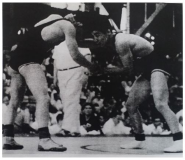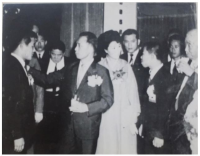The purpose of the study was to investigate the meteorological and environmental information which should be provided for a winter sport event from the users' point of view, and to provide the fundamental data for the construction of the meteorological information to be specified in a sport event. For this study, some case studies were conducted at the center of Winter Olympic Games. Essential meteorological elements which should be fundamentally provided for a sport event were analyzed. Also, in-depth interviews with athletes, coaches were held to explore the meteorological elements needed from the users' point of view. On the basis of the results analyzed from the study, considerable meterological and environmental elements for supporting 2018 Pyeongchang Winter Olympic Games were suggested through the discussions with meteorological and sport event experts. As results of the study, essential requirements regarding the meterological and environmental information were extracted. Based on the essential requirements, a method of constructing the information in support of meteorology for Pyeongchang Winter Olympic Games was presented.
PURPOSE This study aimed to identify and establish ESG activity assessment factors tailored for sports brands, offering a foundational framework for fostering sustainability within the sports industry. METHODS A Delphi survey was conducted between December 1, 2022, and January 31, 2023, involving university professors, sports brand executives, ESG researchers, sports marketing majors , a nd sports brand influencers. Data were analyzed using SPSS WIN 24.0 and MS Excel, encompassing research subject classification, consistency verification, and empirical analysis. RESULTS The assessment of ESG activity evaluation factors of sports brands revealed that governance, social, and environmental dimensions ranked in descending order of relative importance. Among specific evaluation criteria, the adoption of employee ethics regulations was deemed paramount in the governance evaluation area, while support for stakeholder welfare and social well-being took precedence in the social evaluation category. In the environmental sector, the production and delivery of eco-friendly, durable products held the highest significance. Further analysis, considering the weighted priorities of all evaluation factors, emphasized the importance of factors, such as the adoption of employee ethics regulations, support for stakeholder welfare, social well-being, and the production and delivery of eco-friendly, durable products. Conversely, disclosure of company information and issues, support for the underprivileged, and general shareholders' meeting or agenda for the protection of shareholders' rights and interests ranked lower. CONCLUSIONS In summary, this study validates the role of governance (G) aspects within ESG activities for sports brands, alongside environmental and social dimensions. It highlights the importance of a balanced ESG framework, particularly in an era marked by heightened social responsibility awareness among consumers. Prioritizing governance in marketing strategies not only distinguishes sports brands but also necessitates impactful promotion and advertising efforts.
Purpose Student-athletes in Korea are confronted with career development in both academics and sport. This paradigm change in sport policy aims at guarantee of student-athletes' learning rights and successful career transition after sport. But dual career development can be a difficult task for student-athletes, if there is a lack of social support. The purpose of this study was to provide updated information regarding the burnout-in-sport literature and suggest directions for future research in sport psychology. Methods This study is based on reviewing the literature. In order to improve the validity of discussion, the author focused on the findings of the published research articles targeting student-athletes. The outcomes were examined and discussed based on models and measurement tools of athletes’ burnout. Results First, longitudinal study is needed to understand causalities in sport burnout. Second, it is necessary to develop korean sport burnout scale reflecting our social and cultural contexts. To do this, qualitative research should be preceded to provide in-depth understanding on burnout phenomenon of student-athletes. Third, the cut-off values which can allow the separation between clinical and nonclinical athletes should be developed. Fourth, due to dual career development as a new sport environment, burnout research has to pay attention both psychological variables in person and environmental variables. Conclusions Since the 1990s burnout research in sport psychology has been increased in its quantity as one of the remarkable topics in Korea. Based on the comprehensive and systematic review of the literature, directions for future research are suggested.
This study was to explore the factors influencing Olympic performance positively and negatively. In order to achieve this purpose, 60 athletes, who participated in 2012 London Olympic games, responded on open-ended questionnaire. In addition, 10 athletes, who won medals in London Olympic, responded on in-depth interview. Collected data were analyzed by deductive content analysis. The results of this study were as follows: firstly, the factors influencing Olympic performance positively were psychological preparation, strengthening training, physical conditioning, support from significant others, material support, cheering of Korean people, self respect as a Korean national athlete, different game environment, team cohesion, sharing Olympic experience, and support of sports science. Secondly, the factors influencing Olympic performance negatively were psychological pressure, excessive expectation, negative interpersonal relationship, condition decline, overtraining, unstable environment, insufficient facilitation, decrease in performance level, and especially ineffective village room placement and media management during Olympic period. Thirdly, the differences between Olympic games and other world competitions , perceived by athletes were competition scale, psychological attitude, training support, systematic preparation, and benefits from winning medals. The results of this study will give fundamental information in developing a scale which can measure Olympic preparation level and in developing Olympic preparation guideline. Therefore, it will help athletes ,who participate Olympic for the first time or athletes who did not perform well in pre-participated Olympic games, to understand and apply in training the factors influencing Olympic performance and help them to perform better in Olympic games.
Purpose This study is to investigate the human rights violations of Semi-professional team athletes. Methods The subjects of the survey were 4,069 people in total of 56 sports athletes from teams. than, 1,251 athletes who agreed to provide personal information (635 males and 616 females) were sampled. The survey tool consisted of a total of 76 questions asking about violence, sexual violence, and general characteristics of semi-professional athletes. Results were frequency analysis, cross-analysis, and multiple response analysis. Results Despite being an adult athlete in the semi-professional Team's Workplace Sports Team, life controls were severe in the sports team and human rights violations, such as verbal and physical violence, were widely observed, and sexual harassment and sexual violence were not small. The main perpetrators were the leaders and senior players, and the venue was the training ground. The players were in an environment where they were forced to respond passively for fear of hierarchical, collective atmosphere and personal disadvantages, and were blind spots for labor rights in terms of contracts and treatment. Conclusion To human rights violations of semi-professional athletes as the structural problems of the Korean sports. It is necessary to strengthen human rights education by the workplace movement department and conduct regular human rights surveys, and legal institutionalization to establish a disciplinary information system for perpetrators. In addition, by enacting guidelines for human rights in the sports world, a system should be prepared so that the victims can actively express their intentions.

The human foot is only part that directly contact between the body and the external environment, and is ideally positioned to provide sensory information to the Central Nervous System (CNS) during static and dynamic tasks. Through cutaneous mechanoreceptors located in the dermis, the foot is able to recognize touch pressure and vibration stimuli, which provide important feedback information used for the fine coordination of movements. The purpose of this study is to quantitatively examine the effect of changing the foot cutaneous sensory by temperature stimulus on maximal performance and muscle activation using wavelet technique. Sixteen healthy subjects volunteered to participate in this study (Male: Age 21.4±2.4years; Height 174.7±5.3츠; Weight 70.6±5.2kg; Female: Age 20.5±0.6years; Height 163.2±3.1cm; Weight 55.6±4.8kg). Sensory pressure thresholds were determined for the plantar surface of the foot using monofilament. Kinematic, kinetic and EMG data which relative to maximal performance were collected while squat jumping in each temperature condition(cool 12-15℃ normal 28-30℃ hot 45-48℃). Maximal jump height was significant higher in normal condition. Vertical GRF in normal condition showed higher peak value the other conditions. And then EMG signal were significant different between temperature conditions during maximal performance. By changed sensory feedback on temperature, one can alter maximal performance and muscle activation pattern. Cutaneous feedback is important in performance and neuromuscular control, and temperature changes significantly influence on lower extremity during maximal squat jump performance of healthy subjects.







[Purpose] The purpose of this study was to investigate the process of Jang Changsun’s winning gold medal in the 1966 Toledo World Amateur Wrestling Championship and its meaning. [Methods] Jang Changsun and Katsumura Yasuo who had competed with Jang Changsun for the gold medal were selected as participants, a player and an executive who had participated in the Championship were selected as informants. Data had been collected by in-depth interview were analyzed firstly by using the Patton(1991)’s data analysis method, and the following conclusions were obtained by comparing with preceding studies, press releases, reports etc. [Results] Jang Changsun won a gold medal through the three stages of desperate struggles. The first struggle was to loose weight. Jang Changsun lost three times more weight than other players through fasting treatment, intensive training and dehydration in order to secure an advantageous position in the competition. His second struggle was the sparring itself. He made his mind to win gold medal 2 years before the Championship and started to strengthen his physical fitness and polish up his techniques to fight with strong players from powerful nation of wrestling. He finished the sparring by winning 4 games and tieing 2 games resulting in the same deduction points with Katsumura. It was inevitable for him to fight desperately to lose weight again to get gold medal. He eventually won the gold medal by losing his weight until he fainted because of injuries and serious dehydration. [Conclusion] The first gold medalist Jang Changsun contributed a lot to development of Korean sports by offering chance to consider significance of improving elite player’s exercising environment, scientific coaching, gaining self-confidence to win medal, and realizing the importance of sports informations.


Purpose The purpose of this study was to understand student athletes coaches’ occupational challenges from the dual perspectives(social relationship-political system), to analyze the nature of the coping strategies for the challenges, and to provide implications for building a human rights-friendly student athletes club culture. Methods Five coaches(n=5, average career length= 19.2 years) were selected through purposeful sampling. Data were collected by semi-structured interviews with participants. The collected data were inductively analyzed(Patton, 2015). Results First, participants struggled with informal roles demanded by the interested parties(principals, athletic directors, parents, and university coaches). Second, the system for protecting student athletes’ learning rights, the 52-hour work system and the human rights system added difficulties to the coaches’ work environment. Third, the disharmony between interested parties’ demands and government agencies’ institutional ideals pushed participants to choose anti-institutional, un-ethical, un-educational coping strategies. Conclusion The findings suggest that the government, academia and the community should empower coaches as ‘the subject of reform’ who can solve the problem together rather than regarding them as ‘the object of reform.’ Furthermore, this conclusion is expected to provide implications to alleviate disharmony between interest parties’ demands and government agencies’ systems.’